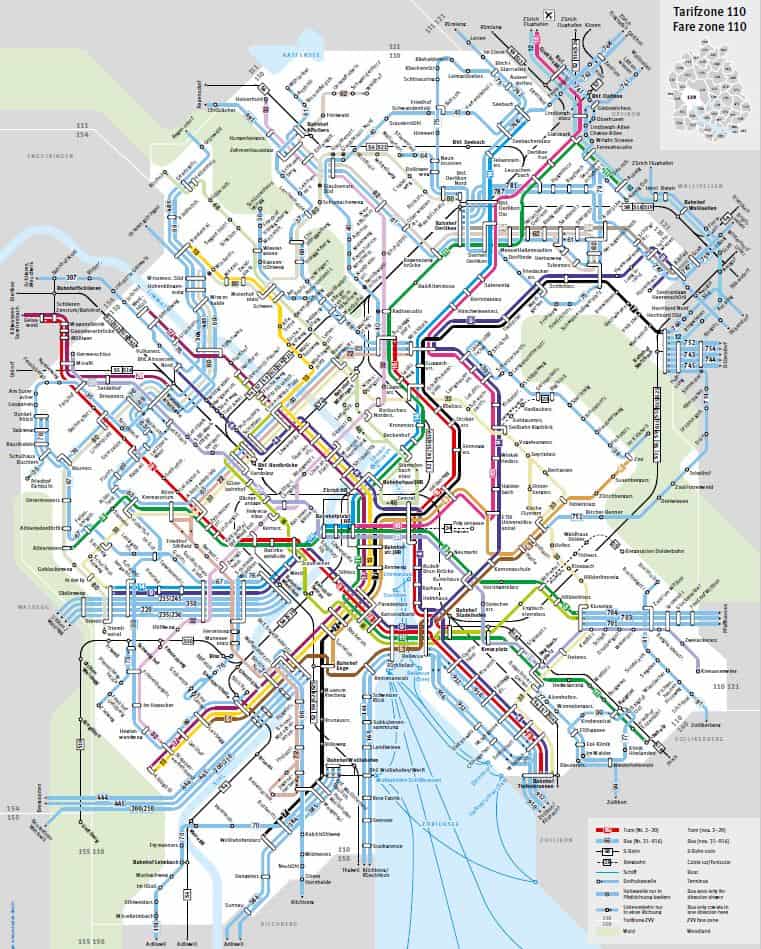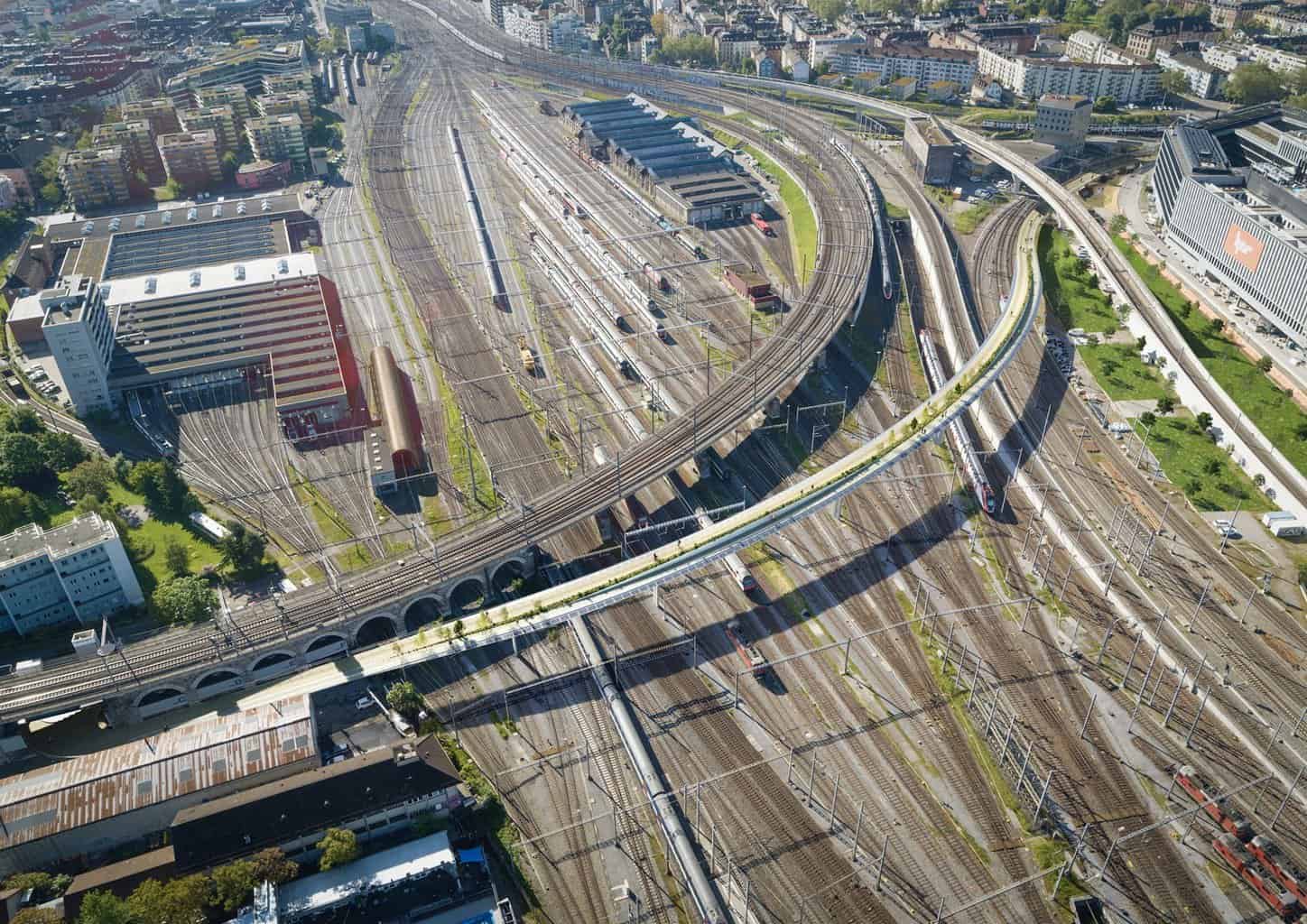
[Panorama Sustainable Cities] #5 How Zurich has become a benchmark in the field of sustainable mobility
4 minutes of reading
in partnership with


Switzerland is often praised for its quality of life. There are various economic and financial reasons behind this proclaimed well-being. But how does it manifest itself in everyday life? We’re going to take a closer look at a crucial factor in determining whether a city “lives” well: mobility.
Encompassing a plethora of issues, mobilities present a major area of concern for the well-being of residents, particularly in urban areas. Whether in organising the flow of people, reducing air pollution and noise pollution, developing soft mobility, or finding substitutes for private vehicles, mobility is a key aspect of the ecological transition and is essential to the comfort of users.
The city of Zurich understood this a long time ago and made it a priority. As a matter of fact, it often ranks among the top cities in European or global in this area.

Strong economic development
To give a few examples, Zurich ranked 5th in the Urban Mobility Readiness Index 2022 (and 2nd in the Public Transport category), 1st in European mobility ranking of the Omio travel site in 2019, and 2nd in the 2017 Sustainable Cities Mobility Index of Arcadis, a company that performs analysis and consulting on urban issues. Zurich is the largest city in Switzerland and the capital of the eponymous Canton, with a population of 430,000 inhabitants (over one million with the greater metropolis area included). It’s also the country’s economic and financial capital. In recent years, the city has boomed, becoming an internationally renownded finance centre. It’s very attractive, and its population is growing rapidly. About 500,000 people work in Zurich and therefore commute into the city daily. Half of them take the shuttle from the outskirts of the city to its centre every day. This is problematic, as transport and road networks can become overcrowded. Mobility is therefore an important issue in this geographical area. Zurich is a compact city, so distances are relatively short. For a long time now, the people of Zurich have been accustomed to using the many options of sustainable mobility available: walking, cycling, or travelling by public transport, making use of the networks and infrastructures the city has been operating for several decades.Ultra-efficient public transport organised in a network
Zurich owes its high rankings in the field of mobility primarily to its highly efficient public transport network, which is considered one of the best in the world. Exceptionally vast and reliable, it is very popular among the city’s inhabitants. The numbers speak for themselves: 14 tram lines serving 172 km of tracks, 14 bus lines, and 6 trolleybus lines spanning a total length of 54 km. Considering how tightly packed the Zurich area is, what these figures mean is that the network is very dense. Public transport therefore criss-crosses the Zurich urban area in most optimised manner.
Zurich’s ZVV public transport network
So, the key to Zurich’s success is an extensive system that not only spreads throughout the city and its outskirts, but also operates in a network: ZVV, Zürcher Verkehrsverbund, the largest public transportation network in Switzerland. This network incorporates a wide range of transport options (bus, tram, shuttles, cable cars, boats on Lake Zurich and the Limmat River, etc.) made possible by the city’s compactness and its geographical layout. In short, the network is a well thought-out, integrated, multimodal system that enables smooth travel throughout the urban area. Since all these modes of transport form part of the same network, a single unique ticket is valid on the entire network, whatever the transportation used. For that reason, it is also an affordable network. So, it is accessible to most inhabitants. It is largely due to the metro (underground) that Zurich’s public transport system has flourished so rapidly. In fact, to be precise, it is due to the rejection of the metro. Indeed, the quality of local public transport springs from the population’s rejection of the large metro project presented in the 70s. After the 1973 consultation brought the project to a halt, the city decided to allocate budgets towards tramway and bus lines instead, to develop and modernise the network and transport offer already in place, with a focus on continuity. The city also drew on various municipal programmes. For instance, the “Stadtverkehr 2025” urban traffic programme was implemented in 2012 to develop the public transport network, with the aim of alleviating congestion in the city. This programme is based on efforts to make public transport more available and attractive, and to improve pedestrian and cyclist traffic. The goal is for public transport, pedestrian, and bicycle traffic among the overall volume of traffic in the city of Zurich to each increase by 10% in 10 years. And in parallel, to reduce car traffic by 10%. Last but not least, Zurich’s rail transport system is particularly advanced. The city operates the S Bahn Zurich, the largest Swiss regional express network, and Zurich’s central station is the largest in the country with no fewer than 2,000 trains and 500,000 passengers going through it every day.Develop infrastructure for soft mobility
To achieve a good balance between all modes of transport, the city of Zurich has also focused on fostering the growth of “soft” transport, such as walking and, above all, cycling. In 2019, under the Stadtverkehr 2025 Programme mentioned earlier, it was observed that the frequency of cyclists passing through automatic counting points had increased by 57% compared to 2012. Alongside its long-term mobility strategy, the city has developed various major infrastructures to support such growth and serve the rising number of cyclists. These developments allow cyclists to make their way through Zurich easily and safely. In September 2022, the population voted overwhelmingly in favor of creating, within the next ten years, fast lanes reserved for cyclists connecting the neighbourhoods on the outskirts of the city to the city centre. These 50 km of “bike routes” are fast lanes specifically for bicycles and prohibited to motorised vehicles, other than residents and emergency vehicles. In a similar move aligned with Switzerland’s particular brand of participatory democracy, the people of Zurich voted in 2021 for the creation of a cycling tunnel passing under the train station, starting from an existing road section. Work is currently underway to rehabilitate this abandoned 200-metre highway ramp, to be finished by 2024. This will allow cyclists to save a considerable amount of time in “crossing” the structure, and to do so in complete safety. 27 million Swiss francs (approximately 28 million euros) have been invested by the Municipality. Lastly, in May this year the city announced the construction of a 530-metre-long bridge specifically for soft mobility above train station’s railway tracks. The project is called “Landschaftsbrücke” (“Landscape Bridge,” because it features a strip of greenery separating the pedestrian path from the bicycle path) and work is set to begin in 2028, at a cost of around 75 million Swiss francs (78 million euros).
The “Landschaftsbrücke” project – Crédit image: PD
Reducing car traffic
The municipality knows perfectly well that it must speed up its efforts on car traffic. To move the growth of sustainable mobility forward, the city must develop further infrastructure and security that reduces the movement of private vehicles. The latest projects show a genuine desire to catch up with leaders in this field, such as Oslo or Amsterdam. Changing the arrangements of lanes and roads makes driving an increasingly inconvenient option. To discourage car traffic, parking spaces are gradually being cut back, more and more areas are being prohibited to car traffic, and the costs of owning a private vehicle are rising. Langstrasse, an emblematic street in downtown Zurich, provides the perfect illustration of this, as it has been partly closed to motor vehicles. As part of its urban planning strategy, the city of Zurich is therefore implementing a policy against cars in its city centre. The aim is both to facilitate soft mobility and to reduce air and noise pollution. The EEB (European Environmental Bureau) actually ranks the city as the top European capital for pollution control.New mobility services
Step by step since 2012, the city has been setting a maximum speed limit for of 30 km/h for road traffic (in the 30 zones), one neighbourhood at a time. The plan is to take this a step further and extend this limitation to the city’s entire road network by 2030. Keeping cars down to such low speeds results in fewer traffic jams and improves the safety of street users. Furthermore, it has been demonstrated that noise pollution has decreased by 2.4 dB(A) during the day and dropped to 4.5 dB(A) at night when the speed limit on the roads concerned is reduced. A survey conducted among users shows a very positive level of acceptance of this type of measures. Another interesting finding is that the proportion of households without a car has risen from 40% in 2000 to 50% in 2019. Such figures are convincing enough to fuel the municipality’s new global strategy entitled “Stadträume und Mobilität” (“Urban Spaces and Mobility”). The Zurich municipality is also leading the way in the development of new uses through digital technology and the arrival of Maas. For example, car sharing is widely practiced in Zurich, along with other shared self-service mobility options (such as bicycles or scooters). Other examples include ride pooling (trips made with other people going in the same direction) and the on-demand public transport service, recently tested over an 18-month period and now awaiting deployment.More reading
Read also




What lies ahead? 7 megatrends and their influence on construction, real estate and urban development
Article
20 minutes of reading

